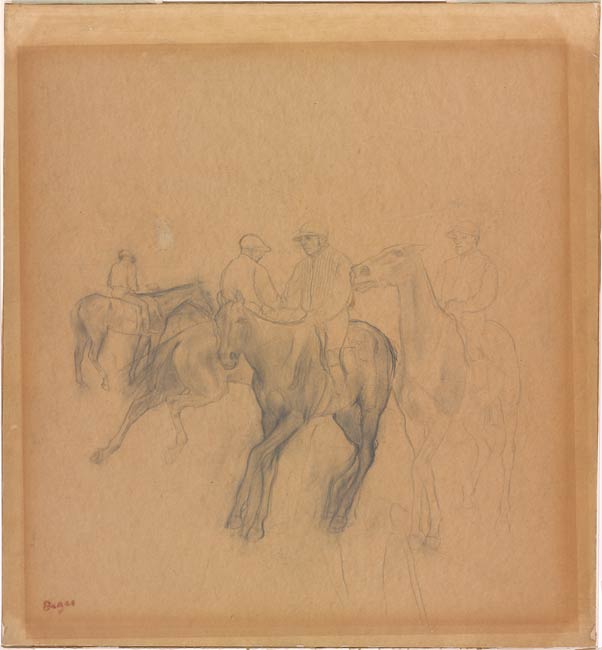
The theme of horses and jockeys occupied Degas ever since his return from Italy in the early 1860s. Often evocative combinations of colorful jockey's silks, greensward, and sky, these scenes are complex. Rather than literal depictions of races or horse track activities, Degas's compositions were constructed from elements he found intriguing. His earliest racing scenes are among the first of his subjects taken from contemporary life. The present sheet provides an exceptional example of how Degas worked, reworked, and revised a particular scene over a significant span of years, along with his remarkable inventiveness in creating new work while revisiting previous efforts.
Degas initially executed this compositional study on tracing paper in relation to the ca. 1868 painting on panel Racecourse Scene (Weil Brothers-Cotton Inc., Montgomery, Alabama). In addition to reworking the original canvas years later, Degas also returned about a decade later to the composition--and the present drawing--to produce a variation of the scene, Jockeys Before the Start, in 1878-79 (The Barber Institute of Fine Arts, Birmingham).
The Montgomery painting corresponds closely to this sheet and is on the same scale but also includes an elegantly dressed couple in the foreground and a landscape setting. Pickvance (Edinburgh 1979) concluded that after making numerous independent studies for the couple, the jockeys, and the horses, Degas executed this sheet to combine the elements in the last stages of preparing for the painting. That this sheet is subsequent to the other known studies is supported by faint outlines in graphite in the foreground of the woman and her companion: vertical marks to the right of center seem to correspond to the cane and legs of the male. A horizontal line through the knee of the central jockey indicates his top hat; marks to the left suggest the parameters of the woman's skirt. That Degas used tracing paper, however, raises the question of whether it was made after the painting. It does not seem to correspond so exactly to the Montgomery canvas to be a tracing of it, although that would better explain the partial outlines of the foreground couple. The numerous pentimenti, especially in the positioning of the legs of the horse at center and the head of the horse at left, as well as the position of the central jockey's legs, suggest that it was indeed a working drawing in 1868 and not a replica of the canvas.
For Jockeys Before the Start, Degas began anew on paper twice the size of the Montgomery panel, altering the composition by eliminating the central horse and rider and bisecting the scene with a vertical starting pole in the foreground. For this version, he combined some of his earlier studies with new works to prepare for the modified composition. He also revised some elements when executing the painting, such as the position of the jockey second from left, who now leans back to rein in his horse. The horse and rider at far right on the present sheet became more prominent in this later painting. Jean Sutherland Boggs (Washington 1998, p. 115) argued that Degas arrived at the solution as he returned to the present sheet to rework it while preparing for the Birmingham version, likely after it was mounted to board, which allowed for the vigorous reinforcement of the contours of the horse at center. For the later painting, Degas also returned to an individual study of the jockey on horseback at far right made ca. 1868 (Art Institute of Chicago). There are additional studies of horses related to the Birmingham composition, including one for the principal horse that corresponds to the horse at right of the present sheet, in the Morgan's collection (2017.57). Degas's reuse of elements and reversion to earlier works in combination with new studies helps explain why he rarely considered anything finished and why so much material remained in his atelier upon his death.
Atelier stamp in red ink at lower left, Degas; on reverse of board stamped in red ink, Atelier Ed. Degas, encircled.
Howard de Walden, Thomas Evelyn Scott-Ellis, Baron, 1880-1946, former owner.
Thaw, Eugene Victor, former owner.
Thaw, Clare, former owner.
The Morgan Library & Museum, New York, NY, "Drawn to Greatness: Master Drawings from the Thaw Collection", 2017. Exh. cat., no. 84, repr.
Stampfle, Felice, and Cara D. Denison. Drawings from the Collection of Mr. and Mrs. Eugene V. Thaw. New York : Pierpont Morgan Library, 1975, no. 96.
100 Master drawings from the Morgan Library & Museum. München : Hirmer, 2008, no. 87, repr. [Jennifer Tonkovich]
Degas, Edgar, Pickvance, Ronald, National Gallery of Scotland, Edinburgh Festival Society, and Glasgow Art Gallery Museum. "Degas, 1879 : Paintings, Pastels, Drawings, Prints and Sculpture from around 100 Years Ago in the Context of His Earlier and Later Works : Catalogue / by Ronald Pickvance ; an Exhibition Organized by the National Galleries of Scotland and the Edinburgh Festival Society, in Collaboration with the Glasgow Museums and Art Galleries ; National Gallery of Scotland, The Mound, 13 August to 30 September, 1979." Edinburgh: National Galleries of Scotland, 1979.
Boggs, Jean Sutherland., Sturman, Shelley, Barbour, Daphne, Jones, Kimberly A, and National Gallery of Art. "Degas at the Races / Jean Sutherland Boggs ; with Contributions by Shelley G. Sturman and Daphne S. Barbour and Kimberly Jones." Washington : New Haven: National Gallery of Art ; Yale UP, 1998.
